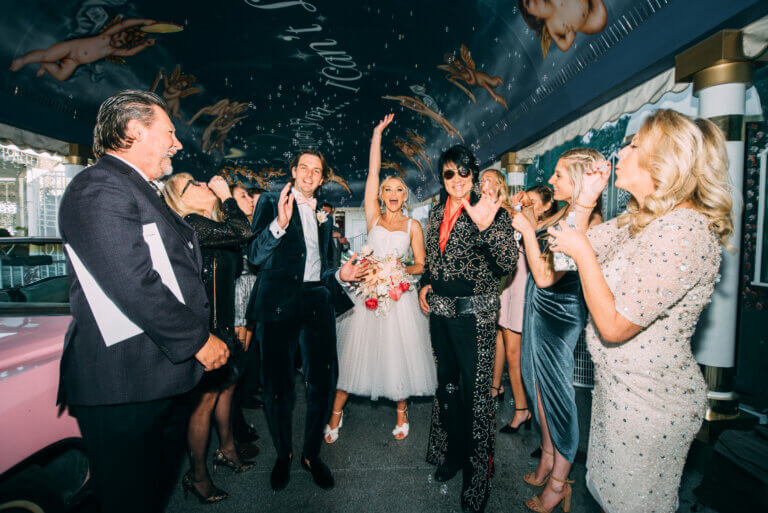By: Tyler Schneider | Las Vegas Weekly

Las Vegas’ iconic wedding industry has weathered countless downturns over the decades, but the early pandemic period in 2020 was particularly brutal. That year, Clark County issued 22% fewer marriage licenses than it had in 2019. Luckily, the bounce back was just as swift.
It was a miraculous recovery. From 2021 to 2024, the marriage license totals regularly surpassed pre-pandemic levels, with the local industry generating $2.2 billion in economic activity in 2023, Clark County Clerk Lynn Goya tells the Weekly.
Unfortunately, the first half of 2025 has been a different story.
“If you see a recession like the 2008 housing crisis, you’ll see the number of weddings go down. And the economy has been so uncertain since the beginning of this year that it has impacted weddings as well as tourism,” Goya says.
Through the end of June, her office cites a 2.6% decrease in marriage licenses and a net loss of just under 900 weddings compared to the same period in 2024. It may not sound like much, but for a local industry that Goya says is made up of around 20,000 planners, officiants, bakers, florists and other vendors, it truly adds up.
Local wedding coordinator and Cactus Collective Weddings founder McKenzi Taylor has seen the latest wave of economic uncertainty unfold firsthand. She attributes this moment to a mix of decreased consumer confidence and the fallout from fluctuating tariff rates imposed by the Trump administration.
“We didn’t really see that coming. We were starting to notice, since probably October or November of the prior year, that people were becoming a lot more cautious about their spending in general,” Taylor says. “I couldn’t really predict that tariffs were coming down the pipeline, but I’d say they shocked our industry and blindsided a lot of us.”
Taylor, who is also president of the local Wedding Industry Professionals Association chapter, began her career as a wedding photographer in 2004 and went on to launch her comprehensive wedding planning business in 2017. For her, the slowdown in the first half of 2025 is evident in fewer bookings, significantly more cancellations, smaller guest lists and higher prices for supplies and services. Overall, she says, “less weddings are occurring” here in 2025.
She identifies floral studios as one sector of the industry that’s beginning to get hit by tariff-driven price hikes. Because florists tend to source many of their flowers from more favorable climates in other countries, Taylor says she’s seen local florists increase their prices by 10% to 20% since Trump unveiled his initial tariff rates in April. Her thoughts echo a June 25 report from global marketing firm Associated Luxury Hotels International that cites florists reporting 10% to 25% price increases on “premium blooms” from abroad.
Aside from flowers, the industry relies heavily on imports. According to the National Bridal Retailers Association, China accounts for 90% of the U.S. bridal gown market.
In May, the Trump administration and Chinese government announced a 90-day trade deal lowering tariff rates on most Chinese imports from 145% to 30%, but the arrangement is set to expire on August 12. On July 29, top trade officials from both countries concluded talks in Stockholm, Sweden, but it was unclear as of press time whether President Trump would follow through on extending the trade deal past the original deadline.
Taylor fears that economic uncertainty and price increases could threaten Las Vegas’ role as a destination wedding hub going forward.
According to Goya, roughly 80% of all Las Vegas weddings involve non-locals, with about 20% of those coming from international clients. She adds that the larger wedding sector here accounts for about 4% of all visitor volume, according to data from the Las Vegas Convention and Visitors Authority.
Goya also labels international weddings as one area in which the local industry has made strides in recent years. But Taylor is now seeing far fewer clients from Canada, which are a significant portion of Las Vegas’ foreign wedding share.
October will be a telling month, as Taylor says it typically represents a “boom” in matrimonial activity. At this point though, her fall and winter bookings are still down from last year.
“I think consumer pocketbooks are tightening. … They’re actually getting fearful or complaining more about financial strains than they have historically. So that’s probably really the factor here,” Taylor says.
There’s still room for optimism, however, with Goya noting that the 80,000 or so weddings that occur here annually “still puts our wedding rate way above anybody else in the world that I can find.”
Longtime local officiant Brian Mills, who serves as president of the Vegas Wedding Chamber that Goya helped form in 2016, shares her outlook.
“[We] weathered COVID, and we will make it through this, too. I anticipate next year being a very big year [if] international travel returns, the uncertainty of the political landscape settles and everyone has more discretionary income in their pockets,” Mills says.
In the meantime, industry veterans like Taylor are taking proactive steps to help curb their losses, like running a summer sale and doubling down on outreach and marketing efforts. She also notes that it’s important to lean into emerging trends like a greater interest in outdoor wedding destinations like Red Rock Canyon and Valley of Fire State Park, plus the millennial proclivity for themed weddings.
“There’s still a place for some of those fun, kitschy, super Vegas vibes that you can’t get anywhere else. But the reality is that there are also so many beautiful, scenic places to get married here,” Taylor says. “The goal for us now is to promote the fact that, for every couple that has a vision about getting married, it can all happen in Vegas.”
